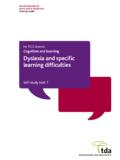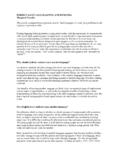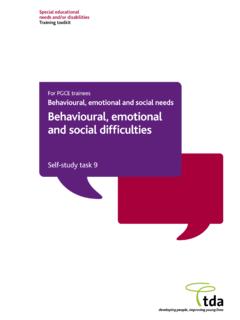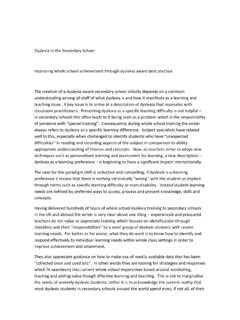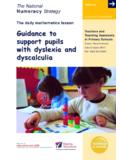Transcription of Chapter 18 Identifying and overcoming the …
1 Identifying and overcoming the barriers to learning in an inclusive context Gavin Reid The two key phrases in the title of this article barriers to learning and inclusive context are of considerable significance in meeting the needs of learners with dyslexia/LD. Most education systems throughout the world are attempting to include children with dyslexia within the mainstream curriculum. This can only be really effective if additional support, or training for teachers is available.
2 It is also important to shift from the mind set of viewing dyslexia as a disability or a deficit to a more positive and pro-active perspective. barriers to learning When Identifying the barriers to learning it is important to look at students holistic needs. This would include: cognitive ( learning skills) environmental ( learning experience) and progress in basic attainments (literacy acquisition). These factors highlight a number of key factors relating to the learner, the task and the learning experience.
3 This highlights the need not to solely focus on the child, and what he or she can or cannot do, but to look at the task that is being presented, the expectations being placed on the learner and the learner s readiness for the task. From that premise the first step is to identify those factors cognitive, educational, environmental and social / emotional that can be presenting barriers to the learner acquiring competent literacy and other skills. It is important that learners with dyslexia gain some success as this will help to develop a positive self-esteem.
4 This is crucial for successful learning . Success can usually be acquired if the learner achieves so it is important to ensure the task is achievable. Dealing with difficulties experienced by the learner It is important to obtain an understanding of the type of difficulties experienced by learners with dyslexia and to identify how these difficulties can be minimised. Some of the potential difficulties are discussed below. Understanding Often the learner with dyslexia may not actually understand the task.
5 This can in fact offer a reason why they can answer a seemingly different question to the one intended. Understanding the task therefore can be a barrier that confronts the student with dyslexia in most subjects. It is not because they do not have the necessary cognitive skills to understand the task but it is because the task is presented in a manner that makes it very challenging for the dyslexic student. Identifying the key points Dyslexic students may have difficulty in recognising what the task, or the text, is suggesting because they have not been able to identify the key issues.
6 They may pick up some tangential issues that side track them into a different path and this can lead to a different type of response from that intended. It is crucial to highlight the key points rather than expect learners with dyslexia to identify these themselves. Processing information Two of the key components that need to be considered in relation to Identifying and dealing with the barriers for learners with dyslexia relate to the distinction between processing and reasoning. Often the person with dyslexia will have good reasoning ability given that the barriers have been removed they will be able to access thinking skills and show good comprehension.
7 The processing of information however which is often noted in the output that is the written work may be more challenging. Processing involves Comprehending the task - that means the learner has to be able to access the vocabulary and the purpose of the task - for some learners with dyslexia this can be demanding. This highlights the importance of pre-task discussion. During that time the teacher would discuss the task, the vocabulary, the concepts and the purpose of the task with the learner.
8 This is essential to ensure that learner has an appropriate schema for the task as this will assist in the access and utilisation of background knowledge and existing skills. This indicates that one of the key issues is not the what question but the how question - that is how do I do this what information do I need and what do I do first. This means that the learner with dyslexia needs support in the actual learning process. This will be time well spent as it has been indicated that often learners with dyslexia can have low metacognitive awareness (Tunmer and Chapman 1996) indicating the they find the process of learning challenging and once they receive support in this area they can usually deal with the task more competently.
9 Implementation of the task that is being able to use the information provided to assist in the answer to the question. This would have implications for being able to identify the key points and focussing on the actual task. It is possible for learners with dyslexia to be side tracked and look at issues that may be important but may not directly relate to the task. Autonomous learning it is often the case that students with dyslexia become dependent on a teacher or support teacher when they are tackling questions.
10 This means they are leaning towards a dependency culture and becoming too dependent on another person. This in the short term may be exactly what they need but it has dangers. One danger inherent in this can be gleaned from Attribution Theory . This would imply that if learners become dependent on support they will attribute their success to the presence of the teacher. It is important that this attribution is shifted in order that they attribute success to their own efforts. This is the first and essential step to becoming an independent learner.
